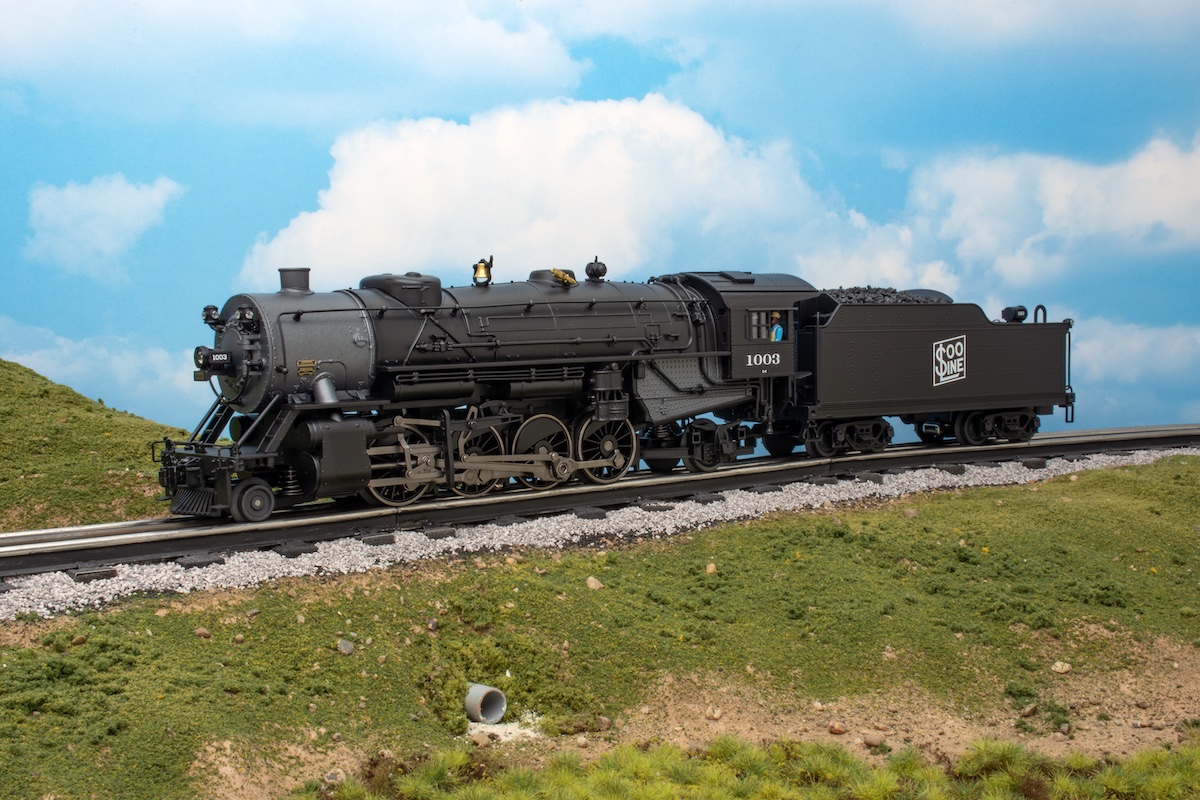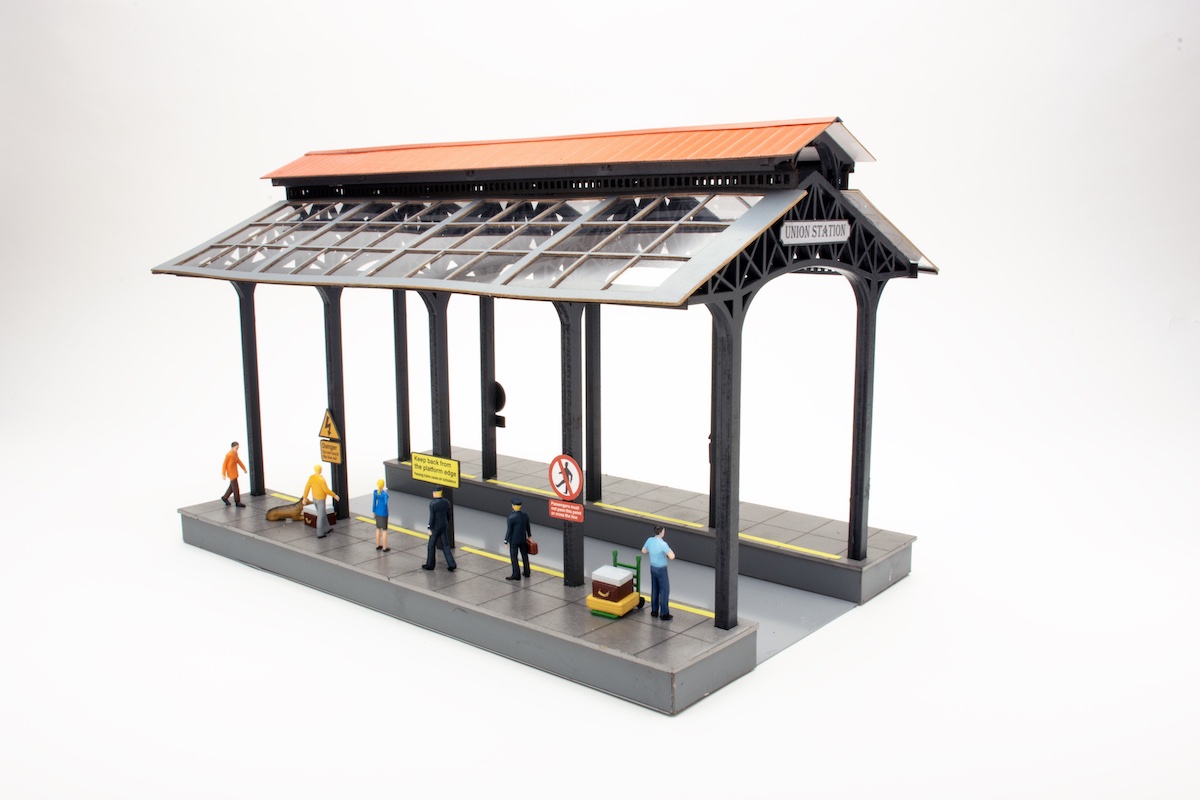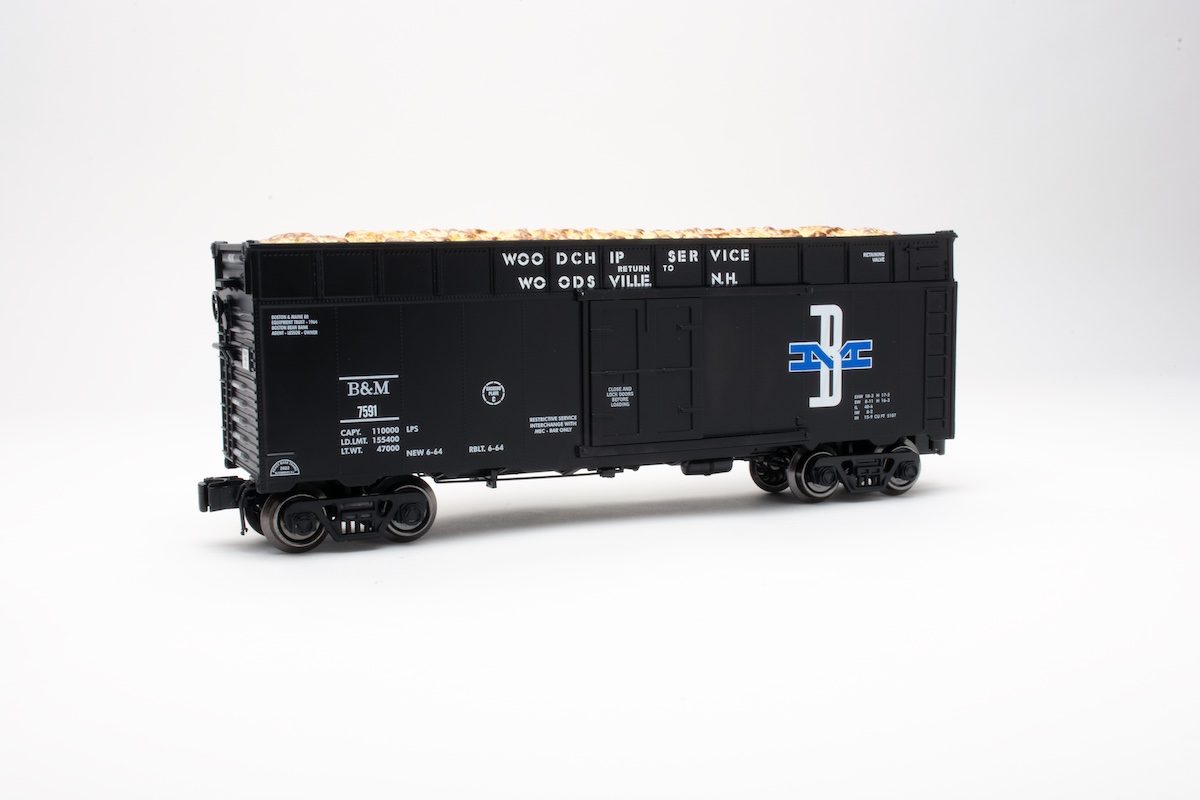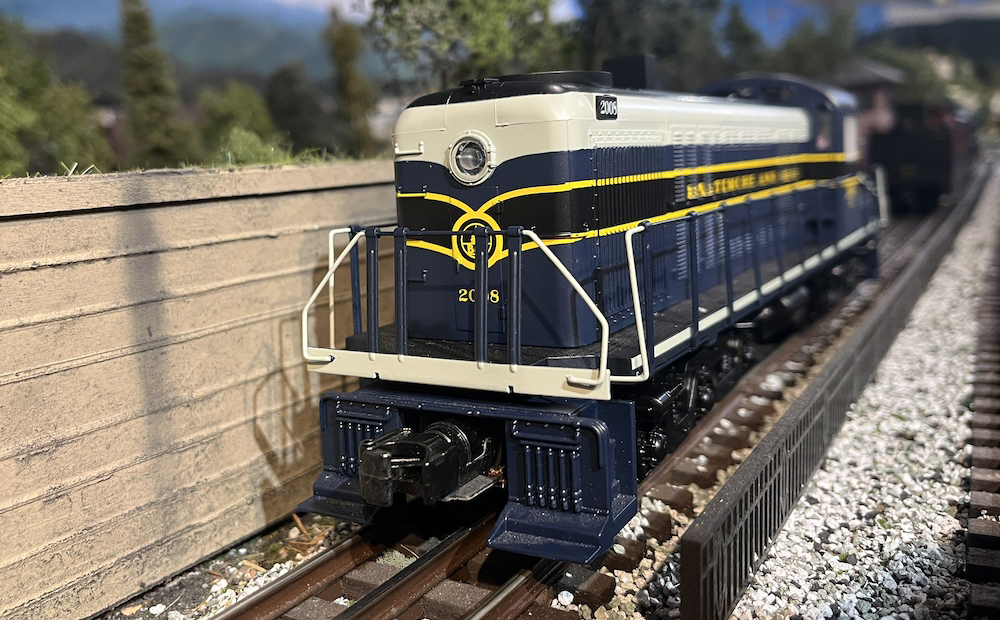The set consists of an HHP-8 (“HHP” stands for “High Horse Power,” and the “8” stands for 8,000) locomotive, three Amfleet passenger cars, a loop of Lionel FasTrack with O-48 curves (to accommodate the long coaches), and a CW-80 80-watt transformer.
The locomotive
The HHP-8 is a bit of an oddball locomotive for Lionel to make – I mean, Baldwin built more Centipedes than Bombardier built HHP-8s. But the stylish, dual-cab electric locomotive does pack quite a bit of pizzazz in the looks department and certainly says, “I’m a train of the future.”
Visually, this is a pretty small locomotive – and I am making no reference to the scale dimensions versus the prototype. A postwar-style GG1 electric looks robust next to it, and the HHP-8 measures 4 inches shorter than the Amfleet cars. This isn’t critical, but if you think you are getting a locomotive that rivals, say a scale-sized rectifier, think again. This is in the AEM7 size range.
Starting out with the pilot, it is gray metal and is attached to the trucks. Each pilot mounts a die-cast metal thumbtack coupler. The sloping nose sports lights just above the pilot, and four more just below the windscreen.
The windshield is deep and would give the crew an ideal view of the right-of-way. Each front pane has a huge (prototypical) wiper arm. When the lights are off, it is a bit tough to see inside the cab, but you’ll find two crewmen and a stylized control panel. This may have the nicest cab detail of any O gauge locomotive I’ve seen. Stating the obvious, the cab is duplicated on both ends.
The roof of the locomotive is amazingly intricate for a value-priced model. There are two pantographs that you can manually raise and lower. You’ll also find a fairly nice array of metal lines representing electrical conduit, along with insulators supporting them over the cab roof. There are three add-on horns nestled on the top as well.
There is a plastic block representing raised screens that snaps into place between the pantographs. This bit conceals the Program/Run, Sound/No Sound (for the horn/bell), and the volume control knob. I found the cover awkward to remove at first (I was taking care not to break it), but once I had the hang of it, removing it was easy.
The sides of the model are nicely detailed. The locomotive has four opening doors (a surprise to me) bracketed by cast-in handrails. There is minimal rivet and seam detail on the lower portion of the body. However, the cast-in side screen that dominates the middle of the body looks very sharp. On the topside, the raised sides (that provide streamlining for the lowered deck and its electrical components) have additional rivet and seam markings.
The battery box between the trucks houses the locomotive’s speaker; it’s painted silver on the sides and gray on the front, rear, and bottom.
Paint application on the locomotive was very good. There were a few blurry spots, but I needed to hold the model 2 or 3 inches from my eyes to define them. The Amtrak Acela-service wing logo was well executed.
The coaches
I really like the passenger cars and suspect they would sell well if offered separately (or in an add-on pack). Like the locomotive, the shells are made of plastic with a sheet-metal frame.
The extrusions on the carbody were well executed and looked pretty convincing. The tooling was very clean.
The window glazing is tinted green, and there’s interior lighting and seating. Considering the fact that the locomotive has four opening doors, I was a bit puzzled that none of the passenger car doors on the sides or ends opened (though there were add-on grab irons by each side door).
I had expected a typical rubber diaphragm on the ends of the cars, but they were rigid blocks. I was impressed to find the doors have three add-on grab irons as well as a tinted window that clearly possesses a black frame similar to that on the side windows.
The end coach has illuminated red marker lights on the rear. The other cars have lenses on both ends of the car, but do not illuminate.
The side of the undercarriage has some nice detail for battery and equipment boxes, but the frame is otherwise free of detail. The truck side frames are nicely done, and they mirror the look of what I saw in prototype images. The cars are very free rolling.
Painting was a bit more complex with the cars than it was with the locomotive. The silver color was uniformly applied. The red, white, and blue accent striping was cleanly executed, especially the small segment between the car door and the end of the frame. Edges were clean, lettering was crisp, and the car-specific lettering (Amtrak, Coachclass, and the handicapped logo) added an extra touch of realism.
On the test track
The locomotive was very quiet and smooth in operation, and was very responsive to commands in both conventional and command modes. The model has two motorized trucks, and each truck has two power pickups.
Our conventional-mode low speed was 23.3 scale miles per hour, and the command-mode low speed was 10.8 scale mph. Our high-speed average was 94.8 scale mph. Drawbar pull was 1 pound, 14 ounces.
The HHP-8 has two power pickup rollers 3 inches apart on each truck, and the trucks are 5 inches apart. The passenger cars have one pickup roller on each truck, spaced 10½ inches apart.
The locomotive is equipped with Lionel’s TrainMaster Command Control system, and we operated the HHP-8 in both conventional and command modes using our Lionel Legacy system.
I was surprised that other than the horn and bell, there was no sound system. Of course, if one had been installed, I’d have included my usual electric locomotive sound system statement about it being as exciting as the sound of a toaster in action. I guess the omission of RailSounds helped to keep the price point lower, which always works for this frugal train guy.
I can’t compare the sound to the prototype, but both the horn and bell tones seemed fine to me.
All couplers are thumbtack-style, so your uncoupling choice is limited to positioning the train over an uncoupling section or using your fingers.
Running as a complete train was just fine. The coaches have a bit of overhang, so if you are running on an already-built layout, you will probably want to operate the train slowly through tight spots on the inaugural run.
Speaking of track, the set includes seven straight sections, one straight lockon section, and 12 O-48 curved sections of Lionel’s FasTrack. The wider-diameter curves are included to give those lengthy cars a functional and more graceful curve to glide through. Even so, the cars had a bit of overhang, even on O-54 track, so be prepared.
A CW-80 transformer supplies power. The transformer gets the job done. It pumps out 80 watts, and you have a second output line to run accessories. During testing, it proved to have more than enough power for this set – worth noting since it didn’t power just a two-motor locomotive, but three illuminated passenger cars as well.
I had no problems operating this set, and it was a fun outfit to run. The O gauge HHP-8 set was well made, will probably be a delight for anyone young or old who receives it, and shows that the folks in Lionel’s product development crew are trying to take the firm’s starter sets to the next level.
Price: $499.99
Features: O-48 operation, locomotive has two can-style motors, Lionel’s TrainMaster command system, and a horn and bell; coaches feature interior illumination. CW-80 power supply and a loop of Lionel’s FasTrack system with O-48 curves.















Great article – very informative.
I'm still looking for 1950s and earlier models, but if I were just getting started this would be a great place to begin. The 042 curves are an addeded benefit / feature and it appears to have few short cuts in the engine and passenger cars.
Had a chance to bring high speed action to my Canadian Pacific layout last night. The HHP-8 locomotive was a smooth (and zippy) performer, but I have to say that the Amfleet passenger cars really did it for me — great to see these mass produced for the O scale market. Maybe they're a tad undersized, but they sure looked the part of a scale coach — especially liked the illuminated red marker lights! Can't wait for the 6-35454 Cab Control End Car to arrive!